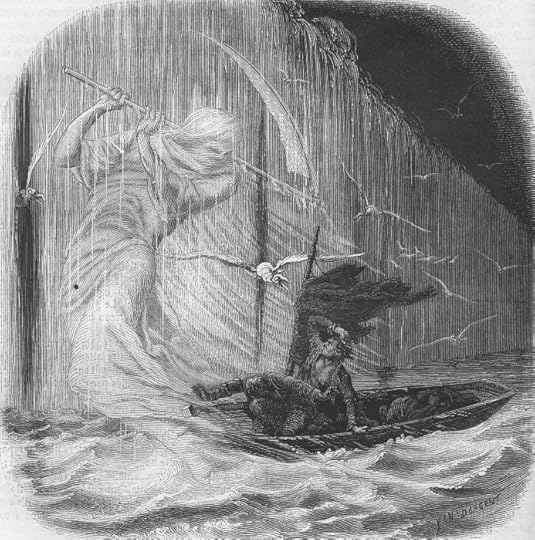Ripley Entertainment Inc.'s Blog, page 205
April 28, 2020
CARTOON 04-28-2020
April 27, 2020
Did Edgar Allan Poe’s Only Novel Predict A Grim Disaster At Sea?
Featured in Ripley's Believe It or Not!

Edgar Allan Poe is one of the most enigmatic and tragic figures in the history of literature. The iconic 19th-century author and critic is remembered for the macabre yarns he’d spin; grim and gothic tales such as The Tell-Tale Heart, The Fall of the House of Usher, and poems like The Raven and Annabel Lee.
His most famous works tend to have some elements of supernatural impossibility to them, so it’s only fitting that several mysterious tales surround Poe’s own life. In fact, the circumstances of his death in 1849, at the young age of 40, constitute an intriguing mystery in and of themselves. As we’ve reported previously, it’s now believed that he died from rabies!
Poe’s Only Novel
One of the most intriguing Poe stories of all, though, revolves around his only novel, the snappily-titled The Narrative of Arthur Gordon Pym of Nantucket. As was Poe’s wont, the book deals with some very grisly and bizarre subject matter, which makes it all the more astonishing that the events of which he wrote actually came true several decades later.

An illustration from Jules Verne’s essay “Edgard Poë et ses oeuvres” (Edgar Poe and his Works,1862) drawn by Frederic Lix or Yan’ Dargent.
Arthur Gordon Pym tells the story of the eponymous character, a young man who drunkenly decides to sail his small boat out to sea. He and his close friend, Augustus Barnard, are caught in a mighty storm and their flimsy craft is lost. They barely survive the disastrous adventure, but Pym is inspired to stow away on a whaling ship, named the Grampus. He and his friend—the son of said vessel’s captain—wind up in an impossible and tragic situation that real-life sailors would relive four decades after the book’s publication!
The Sad End Of Poe’s Richard Parker
While hidden away onboard, Pym is completely unaware of the vicious mutiny that had taken place on the Grampus. Augustus, Pym, and one of the regretful mutineers, Dirk Peters, devise a very Poe-esque plan to take control of the ship: Pym, whom the rest of the sailors haven’t yet seen, dons one of the murdered sailor’s clothes and threatens the mutineers, as a ‘ghost.’ The ship is theirs, but the vicious storm damages it and leaves them without supplies. Another mutineer, Richard Parker, desperately suggests that one of the small party will need to die to provide sustenance for the others. The unfortunate man draws the short straw and is eaten.
In the end, Augustus dies of his wound, but Peters and Pym are eventually rescued, on the verge of death, by a passing ship. It’s typical morose Poe fare all-in-all, but what’s most interesting is what happened decades after the novel’s 1838 publication. The story came to real life.
In 1884, a small craft called the Mignonette set out on a trip from England to Australia. Such a journey would have been painstaking for even the sturdiest ships, and the dinghy had little chance when the storm hit. It was quickly destroyed. The small crew of four were left adrift in a lifeboat with no supplies. One member of the party fell out of the boat at one stage, also taking a desperate swig of seawater. After this incident, he became sick and his three companions, to alleviate his suffering and ensure their own survival, killed him and drank his blood in their desperation. What was the name of the unfortunate 17-year-old? Just as in Poe’s story, he was also a cabin boy named Richard Parker!

Richard Parker’s Tombstone at Jesus Chapel
The Disaster Poe ‘Predicted’
It’s a spooky coincidence worthy of Poe himself, and the story of the killing on the Mignonette was a high-profile court case at the time. R vs Dudley and Stephens set a precedent that ‘necessity’ did not constitute a legal defense in a murder trial, despite established customs at sea regarding shipwrecks. Even more interestingly, the name Richard Parker has cropped up several times—in real life and in stories—surrounding shipwrecked sailors. So popular is this trope that, in 2001, Yann Martel named his similarly stricken at sea Bengal tiger ‘Richard Parker,’ in his novel Life of Pi!
As remarkable an imagination as Poe had, as much as macabre tragedy seemed to ooze from his every pore, it’s tough to claim that he could have seen this coming. After all, he died eleven years after Arthur Gordon Pym’s publication and 35 years before the Mignonette’s doomed voyage. He also seemed to think little of his novel himself: its violence and plot were lambasted by critics at the time and he concurred with them, calling his tale “a very silly little book.”
One thing’s for certain though: the true story may not have been as grisly as Poe’s own. For example, at one stage, Pym and his fellow survivors encounter a Dutch ship they believe is going to save them but turns out to be crewed by decaying corpses. But, it’s a fascinating, impossible, and intriguing coincidence nonetheless.
By Chris Littlechild, contributor for Ripleys.com
EXPLORE THE ODD IN PERSON!
Discover hundreds of strange and unusual artifacts and get hands-on with unbelievable interactives when you visit a Ripley’s Odditorium!
Source: Did Edgar Allan Poe’s Only Novel Predict A Grim Disaster At Sea?
CARTOON 04-27-2020
April 26, 2020
CARTOON 04-26-2020
April 25, 2020
CARTOON 04-25-2020
April 24, 2020
The Glow Up Of The Radium Girls
Featured in Ripley's Believe It or Not!

Your “Glow up” from your teenage self to your present-day self is probably pretty phenomenal. And that’s why we hate to burst your bubble, but we definitely have the glow up of the century.
Nearly 100 years ago, women were working a job far more dangerous and painstaking than they could have imagined. The year 1918 was a time of raging war. With new military technologies and trench warfare, drastic levels of destruction and death were on the horizon. Between soldiers and civilians, more than 16 million people were killed by the time World War I had ended.
Because so many men were enlisted to fight for our country, the dynamic of the common workplace was doing a total 180. To compensate for the vacated positions of males who had gone to war, many women were recruited for jobs to replace them. As mentioned, World War I was a time of innovation. With new weaponry and new technology, the demand for production was at an all-time high.
Munition factories became the largest single employer for women in 1918. And aside from stuffing dynamite and TNT, the ladies of this time were also engaging in a far-more-glamorous—and equally as dangerous—task, dial painting.
Painting clocks, watches, and military dials became the hottest job on the market. But, not every woman could be a dial painter—this was the job every poor working girl wanted. Why? Well, this position paid three times as much as an average factory job, and it gave young women the opportunity to work with the luminous element of radium.

Today, it’s hard to believe that anyone would voluntarily work with radium. But, Believe It or Not!, radium was actually a popular health craze during this time. It was used in everyday products from toothpaste to cosmetics and even in food and drinks. Think of radium as your daily vitamin.
Because of this façade that had been painted across the face of radium, the hype only seemed to increase. Radium paint was applied to wristwatches and clock faces to give them a magical glow. The young ladies working on these timekeepers would dip their brush in the radium paint, bring it to their mouth and point the tip before applying the paint to the dials, ingesting scarce amounts of radium each and every stroke. After a full shift of this behavior, it’s no surprise that the women themselves began to glow.
Heading out on the town for the night, glowing from the inside out, no one suspected that this everyday job was literally killing them. The tricky thing about radium was that, even when the dangers of this element hit the surface, side effects and health issues took quite a long time to develop. Nothing was immediately happening to these ladies and so they went on with their days.

In the early 1920s, some of the Radium Girls started developing symptoms. The first death occurred in 1922 when 22-year-old Mollie Maggia died after reportedly enduring a year of pain. Although her death certificate incorrectly stated that she died of syphilis, she was actually suffering from a condition called “radium jaw.” Her entire lower jawbone had become so fragile and brittle that her doctor removed it by simply lifting it out.
It wasn’t until 1924 that the United States Radium Corporation decided to investigate the effects further. And even then, it wasn’t the end of radium as we know it. It wasn’t until 1968, after years of cases, attempts to sue, health issues, and many unfortunate deaths, that radium was totally phased out of production.
And while the stories of the Radium Girls are very sad ones, we do have them to thank for so many medical advances. Without their fights for justice and countless health ailments surrounding the stuff, we wouldn’t know much about the effects of radium at all.
EXPLORE THE ODD IN PERSON!
Discover hundreds of strange and unusual artifacts and get hands-on with unbelievable interactives when you visit a Ripley’s Odditorium!
Source: The Glow Up Of The Radium Girls
Bring On The Curator Battle
Featured in Ripley's Believe It or Not!

This Week
[April 19-25th, 2020] A new addition to Slytherin House, terrifying museum collections, mystery muscular cats, and the rest of the week’s weird news from Ripley’s Believe It or Not!
The Thunderdome Curator Battle
Northern England’s Yorkshire Museum challenged the curatorial world on Twitter this past week, daring rival museums to tweet the creepiest object in their collection. The museum kicked off the competition with a photo of a 3rd or 4th-century hair bun—bobby pins intact—from the burial of a Roman female. Now, we’d be totally remiss if we didn’t jump in on the action. Ripley’s shared the severed head of Peter Kurten, the Vampire of Dusseldorf, and solicited additions to our human hairball. Many have been left with nightmares thanks to Yorkshire Museum’s thread, but it’s just another day in the office for Ripley’s Believe It or Not!
MUSEUMS ASSEMBLE! It’s time for #CURATORBATTLE!
CARTOON 04-24-2020
April 23, 2020
Did Betsy Ross Design And Sew The First Set Of Stars And Stripes?
Featured in Ripley's Believe It or Not!

Stories of patriotism have long buttressed nationalism in the United States. These legendary tales showcase some of the most colorful and fascinating historical figures involved in the early founding of the country (at least, as later storytellers have painted them). Among this collection of individuals is Betsy Ross. As many of us learned in school, Betsy gained fame by designing and sewing the first flag of the United States.
But is it true that she stitched the original red, white, and blue? Since the story first surfaced in 1870, well after her death, serious doubt has been cast on this theory. With that in mind, let’s dive into the evidence.
How Betsy Became America’s First Seamstress
According to legend, Betsy designed and sewed the first flag in 1776. Interestingly, though, she was never credited with this achievement during her lifetime. This story first surfaced nearly a century later in 1870, as told by Betsy’s grandson, William Canby.
Canby said his grandmother told him about a visit that she received in late May or early June of 1776 by three gentlemen. They were George Ross (a relative of Betsy’s) along with General George Washington and Robert Morris (a financier of the Revolutionary War).
She claimed that during the meeting, the three men presented her with a sketch of a proposed flag. The design included 13 red and white stripes and 13 stars with six points each. They wanted to know whether or not she could sew something similar.
Before agreeing to the project, Ross suggested reducing the star points from six to five and arranging them in a circle. Satisfied with the changes, they commissioned her to begin the work. The next year, Congress voted to adopt this symbol as the first American flag. The vote happened on June 14, 1777. In other words, even Canby’s account precludes the idea that Betsy designed the first American flag. What else does history tell us?
The History Surrounding America’s First Flag
Canby’s story paints a tantalizing picture of how the first flag came into being. Yet, primary sources supporting his story prove scarce. It is conceivable, however, that Colonel George Ross might have recommended her for the job. After all, George Ross was a signer of the Declaration of Independence and Betsy’s uncle through marriage.
Historians also know that Washington and Morris worshipped at the same church as Betsy, making them likely acquaintances. And Betsy did sew flags. One receipt addressed to Betsy dated May 29, 1777, details work on a “ships colours” for the Pennsylvania State Navy Board for a price tag of more than 14 pounds. Unfortunately, we don’t know much more about the design of the flag associated with the receipt. No similar receipts have been uncovered detailing the creation of America’s first star-spangled banner.

General George Washington, Major George Ross, Robert Morris, Betsy Ross with the first American flag
Nonetheless, the origins of the American flag remain more mysterious. Some historians have even attributed the first design to Francis Hopkinson, a New Jersey delegate to the Continental Congress. A signer of the Declaration of Independence, historical documents demonstrate that Hopkinson played a role in designing seals for various departments within the US government.
What’s more, Hopkinson sought payment from the Board of Admiralty for his design of the “flag of the United States of America” in 1780. His petition for payment, however, was denied by Congress because “he was not the only one consulted” on the design. If the smoking gun in the first flag case is a receipt, Hopkinson has a clear leg up on Betsy.
An Anachronistic Concept
Of course, the whole concept of the American flag’s significance has evolved. When the American Revolution first broke out in 1775, colonists didn’t unite under a single banner. Instead, they fought under regimental or unit flags. The most famous of these? The coiled rattlesnake with the slogan, “Don’t tread on me.”

Some historians even claim that General Washington fought under the British Union Jack at the outset of the war. David Martucci, of the North American Vexillological Association, the world’s largest organization dedicated to studying flags, has thoughts on the subject. He theorizes the flying of the British flag represented a “compromise between the radicals who wanted to see a separate nation and the people who were more conciliatory and wanted to see some accommodation with the crown.”
At some point, however, Washington realized that flying the same flag as the enemy was a point of serious confusion. Hence, the eventual adoption of the stars and stripes in 1777. As for average Americans flying the flag? This practice didn’t become common until 1861 when the Civil War broke out. During the War Between the States, Northerners came to see the flag as a quasi-religious symbol. Just nine years later, within this new patriotic culture, the Betsy Ross story was officially born, and Americans eagerly embraced it.
By Engrid Barnett, contributor for Ripleys.com
EXPLORE THE ODD IN PERSON!
Discover hundreds of strange and unusual artifacts and get hands-on with unbelievable interactives when you visit a Ripley’s Odditorium!
Source: Did Betsy Ross Design And Sew The First Set Of Stars And Stripes?
CARTOON 04-23-2020
Ripley Entertainment Inc.'s Blog
- Ripley Entertainment Inc.'s profile
- 52 followers




 CARTOON 04-26-2020
CARTOON 04-26-2020




